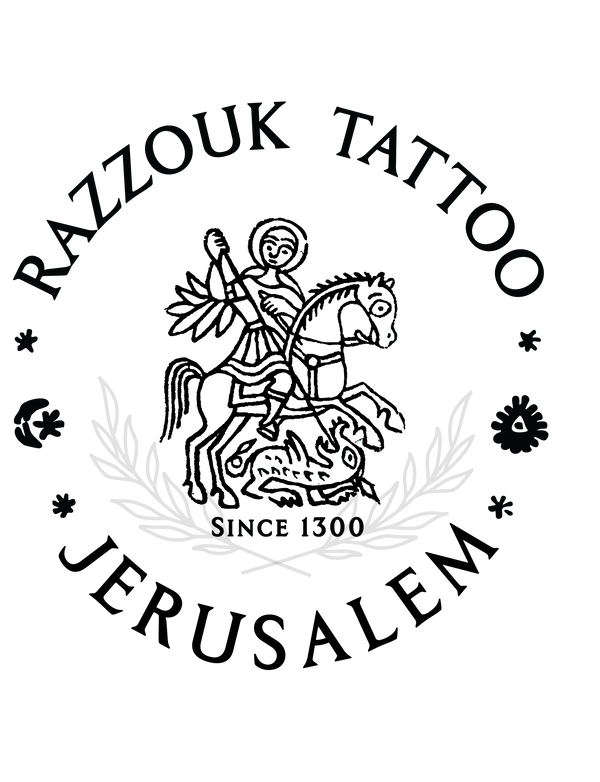History
The Legacy of Razzouk Tattoo: A Timeless Journey
Tattooing is more than an art—it is a story passed down through centuries. At Razzouk Tattoo, this story began over 700 years ago in Egypt, where our ancestors tattooed Christian Copts with small crosses on their wrists to grant them access to churches. These tattoos, given from infancy, became a mark of faith and identity. Five centuries ago, our family brought this sacred tradition to The Holy Land, making Jerusalem the heart of religious tattooing for pilgrims from around the world.
The Founders of a Tradition
Our journey began with our ancestors, who carved intricate tattoo stencils from wood, inspired by biblical motifs such as the crucifixion, ascension, and the Madonna. These blocks became tools of devotion, used to tattoo pilgrims as tangible reminders of their faith and their sacred journey to the Holy Land.
Jacob Razzouk, known as Hagop the tattooer, revolutionized the craft. He was the first tattooist in the region to use an electric machine powered by a car battery and introduced color tattoos. His legacy includes tattooing the Emperor of Ethiopia -Haile Selassie- in the 1930s and mentoring countless artists who preserved Christian tattooing traditions.
A Living Heritage
Today, Wassim Razzouk, the 27th generation, continues this unparalleled tradition alongside his sons, Anton and Nizar. Together, they bridge the past and the present, ensuring this sacred art endures. Pilgrims from across the globe still seek tattoos at Razzouk Tattoo, bearing designs that have been passed down through generations, including the iconic Jerusalem Cross—a symbol of faith and heroism since the First Crusade.
A Tradition Documented
In 1956, historian John Carswell discovered a collection of 168 woodblocks in the Razzouk Tattoo shop, chronicling centuries of Christian tattooing. These blocks, described in his book Coptic Tattoo Designs, showcase motifs that resonate deeply with pilgrims, such as crosses, biblical scenes, and symbols of hope like olive branches. The Jerusalem Cross remains one of the most sought-after designs, embodying the spirit of pilgrimage and devotion.
The Modern Pilgrim’s Journey
Razzouk Tattoo remains a beacon for pilgrims and tattoo enthusiasts alike. While the craft has evolved to include modern tools and designs, the heart of our work remains the same: creating meaningful tattoos that honor faith and history. Each design tells a story—whether it’s a simple cross or a detailed biblical scene—and connects the wearer to an ancient tradition that has endured for centuries.
The Five Generations of the Last Century
-
Jiries Razzouk: The guardian of tradition, who passed down the sacred art.
-
Jacob Razzouk: Innovator and teacher, who introduced modern tools and techniques.
-
Anton Razzouk: A storyteller through ink, who expanded the family’s reach.
-
Wassim Razzouk: The bridge between past and future, preserving and sharing the family legacy.
- Anton & Nizar Razzouk: Anton & Nizar Razzouk: The new torchbearers, blending ancient symbolism with modern expression—bringing the craft to a whole new level while continuing the Razzouk tradition in a global era.
From ancient stencils to electric machines, from Coptic Christians to global pilgrims, Razzouk Tattoo stands as a living testament to resilience, faith, and artistry. The tradition of marking life’s sacred moments in ink continues, ensuring that this extraordinary legacy thrives for generations to come.
